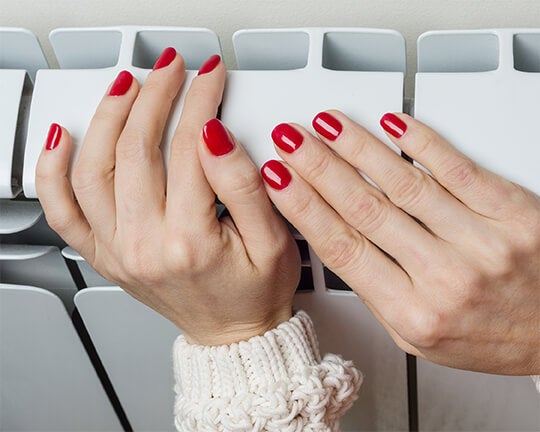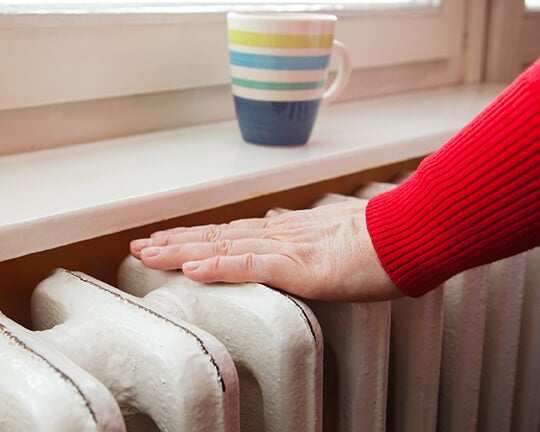Boiler how-to
Cold radiators? What to check
22 Apr 2024 • 5 minutes


Cold radiators are a common problem in many households. While they could be a result of a more serious problem with your central heating system or boiler, there are a number of smaller faults that should be ruled out first.
When you first discover a cold patch on your radiator, check if the:
If none of the above apply, your radiator might be cold if there are:
If none of your radiators are heating up properly, there could be a problem with your central heating system or boiler. However, if some of your radiators are heating up while others aren’t, this could be one of a number of issues. Run through our quick fix checklist below to find out more.
If a radiator in your home isn’t getting hot, it may be due to a problem with one of the zones in your central heating system.
Central heating systems work by pumping a continuous flow of hot-water from the boiler to the radiators, then back to the boiler to pick up more heat. Within this system, you could create ‘ zones.’ This means that you can control the temperature in separate areas of your home, depending on your heating requirements in each room. If you find that radiators are cold in one area, it could indicate that there is a problem with a particular zone.
If one radiator within your home stays cold, ensure that the valves on the sides of the radiator are open. If the valves are open but the radiator is still cold, it’s possible that the valves are blocked. A suitable system cleanse conducted by a Gas Safe Registered engineer will usually do the trick.
If the upstairs radiators in your home are cold, it’s an indication that the feed and expansion tank in your loft has run dry. This usually points to a larger problem. However, it’s also possible that the ball valve in the tank isn’t working correctly; it may be blocked or jammed.
It’s highly recommended that you seek the skills of a Gas Safe registered engineer when you have major heating or boiler problems. Remember that a competent engineer should regularly check and service all boilers and heating systems.
With a full cistern, the upstairs radiators should start heating, but it’s a good idea to get a professional plumber in to work out why the cistern ran dry in the first place.
If your downstairs radiators are failing to heat up, there could be a problem with your pump. If this is the case, it won’t be producing enough power to push the water around the heating system.
Pumps can get warm, but if it is hot or making a grating sound, then it might be about to break down, in which case it will need replacing. One of HomeServe’s Gas Safe registered engineers can provide help and advice to rectify this issue.

If the top of your radiator is cold, it’s possible that air is trapped within the system. Bleeding the radiator will release any trapped air, vastly improving the efficiency of your entire heating system.
If the middle of your radiator is cold, there may be a build-up of debris or sludge which is obstructing parts of the bottom of the radiator. You’ll need to clean it out and remove all unwanted substances that are blocking the bottom length of the radiator.
If your radiator is hot at the top but cold at the bottom, there may be a build-up of scale, rust, or sludge which is obstructing the flow of water.
As with the middle of the radiator, if you have an open-vent system which is unpressurised and tank fed, you’ll be able to use a sludge remover to flush your radiator. However, if you have a pressurised system, you’ll need the assistance of a Gas Safe registered engineer.
If after you bleed your radiators they still aren’t getting hot, you might have a problem with your thermostatic radiator valve (TRV). This issue is usually caused by a stuck pin in the valve. Thankfully, this is easy to check yourself, with no need to call for a professional.
If the issue isn’t your TRV there might be blockages in the system. Unfortunately, this is less easy to fix yourself and we recommend calling in an engineer to flush the system for you.
If you've tried everything and your radiators are still cold, it might be time to call in the professionals, luckily, we know a few!
Ding, a new home repair membership, gives you access to our Gas Safe registered engineers and expert plumbers for £5 a month. So, when you have a problem, you can spend less time searching for a tradesperson and more time getting it done.
Our help & advice articles cover Plumbing, Home heating, Electrical, Energy-saving and Home maintenance.